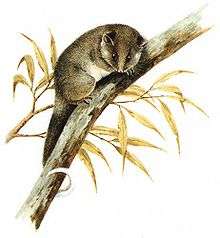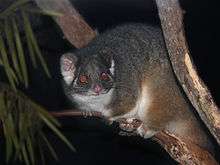Pseudocheiridae
Pseudocheiridae is a family of arboreal marsupials containing 17 extant species of ringtailed possums and close relatives. They are found in forested areas and shrublands throughout Australia and New Guinea.
| Pseudocheiridae[1] Temporal range: Late Oligocene to Recent | |
|---|---|
 | |
| Pseudocheirus peregrinus, common ringtail possum | |
| Scientific classification | |
| Kingdom: | Animalia |
| Phylum: | Chordata |
| Class: | Mammalia |
| Infraclass: | Marsupialia |
| Order: | Diprotodontia |
| Superfamily: | Petauroidea |
| Family: | Pseudocheiridae Winge, 1893 |
| Subfamilies | |
| |
Characteristics
Physically, they appear very similar to the pygmy possums, except for their greater size. Even so, they are relatively small animals, with the largest being cat-sized, and they weigh between 200 grams and 2 kilograms. They have grasping hands and feet with opposable first toes on their hindfeet, and, in all species save the greater glider, a prehensile tail. They are nocturnal, with large eyes.[2]
All species feed almost entirely on leaves. To enable them to digest this tough and fibrous food, they have an enlarged cecum containing fermenting bacteria, and, like rabbits, they are coprophagous, passing food through their digestive tracts twice. Their teeth include a battery of grinding molars, and they lack lower canines. Their dental formula is:
| Dentition |
|---|
| 3.1.3.4 |
| 2.0.3.4 |
Most are solitary animals, although a few live in small family groups, and they are generally shy and secretive, making them difficult to study. They travel across home ranges of up to 3 hectares (7.5 acres).[2] Gestation lasts up to 50 days, but varies depending on species.
Classification
The 17 living species of pseudocheirid possum are grouped into three subfamilies and six genera.
- †Pildra
- †Paljara
- †Marlu
- †Pseudokoala
- Subfamily Hemibelideinae
- Genus Hemibelideus
- Lemur-like ringtail possum, Hemibelideus lemuroides
- Genus Petauroides
- Greater glider, Petauroides volans
- Genus Hemibelideus
- Subfamily Pseudocheirinae
- Genus Petropseudes
- Rock-haunting ringtail possum, Petropseudes dahli
- Genus Pseudocheirus
- Common ringtail possum, Pseudocheirus peregrinus
 Common ringtail possum
Common ringtail possum
- Common ringtail possum, Pseudocheirus peregrinus
- Genus Pseudochirulus
- Lowland ringtail possum, Pseudochirulus canescens
- Weyland ringtail possum, Pseudochirulus caroli
- Cinereus ringtail possum, Pseudochirulus cinereus
- Painted ringtail possum, Pseudochirulus forbesi
- Herbert River ringtail possum, Pseudochirulus herbertensis
- Masked ringtail possum, Pseudochirulus larvatus
- Pygmy ringtail possum, Pseudochirulus mayeri
- Vogelkop ringtail possum, Pseudochirulus schlegeli
- Genus Petropseudes
- Subfamily Pseudochiropsinae
- Genus Pseudochirops
- D'Albertis' ringtail possum, Pseudochirops albertisii
- Green ringtail possum, Pseudochirops archeri
- Plush-coated ringtail possum, Pseudochirops corinnae
- Reclusive ringtail possum, Pseudochirops coronatus
- Coppery ringtail possum, Pseudochirops cupreus
- †Pseudochirops winteri
- Genus Pseudochirops
References
| Wikimedia Commons has media related to Pseudocheiridae. |
- Groves, C. P. (2005). Wilson, D. E.; Reeder, D. M. (eds.). Mammal Species of the World: A Taxonomic and Geographic Reference (3rd ed.). Baltimore: Johns Hopkins University Press. pp. 50–53. ISBN 0-801-88221-4. OCLC 62265494.
- Smith, Andrew (1984). Macdonald, D. (ed.). The Encyclopedia of Mammals. New York: Facts on File. pp. 856–861. ISBN 0-87196-871-1.